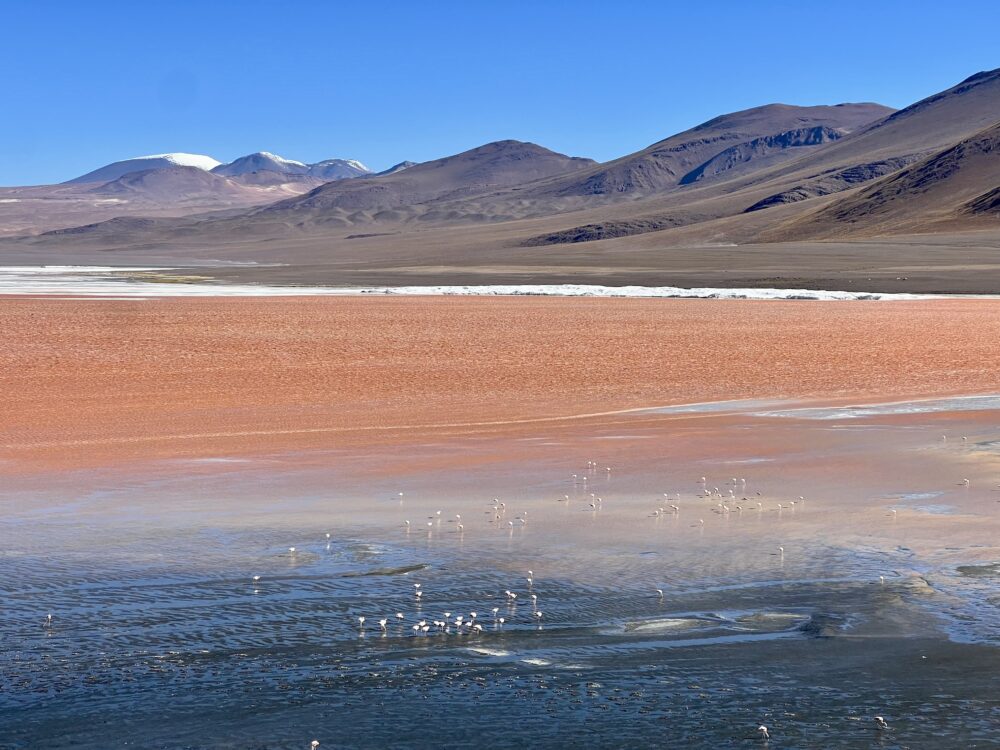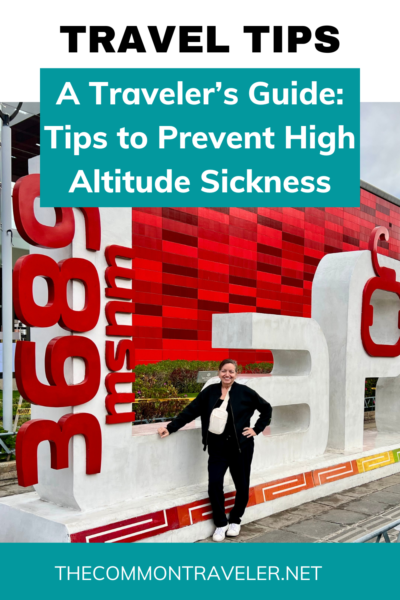We may earn money or products from the companies mentioned in this post.
Traveling to high-elevation destinations can be an exhilarating experience, offering breathtaking views and unique cultural encounters. Some of the world’s best destinations exist at high altitudes. However, the change in altitude can also lead to altitude sickness, a condition that affects many travelers.
Understanding how to prevent and treat altitude sickness is crucial for a safe and enjoyable trip. This guide provides comprehensive information on how to navigate high altitudes effectively. The good news is that some planning can alleviate some of the worst symptoms.
Note: This post is not medical advice. The tips included here are based on my research and experience. Always consult with a medical professional about your situation.
Ideally, you have a few days to acclimate to the higher altitudes. If that’s impossible, consider staying at a lower altitude and taking day trips to higher elevations. Be aware that some medical conditions put you at a higher risk of experiencing altitude sickness.
As someone who frequently suffers from iron deficiency anemia, I was concerned that I would suffer even more, so I discussed potential issues with my healthcare provider ahead of time.

Understanding Altitude Sickness
Many of us live at or near sea level, and there is less oxygen at higher altitudes. The thinner air causes physical reactions in our bodies, making us unwell.
Altitude sickness, also known as acute mountain sickness (AMS), occurs when you ascend to elevations above 8,000 feet (2,400 meters). The body struggles to adapt to lower oxygen levels, which can lead to mild symptoms of altitude sickness such as:
- Headache (most common symptom)
- Nausea or vomiting
- Fatigue
- Dizziness
- Shortness of breath
- Sleep disturbances
In severe cases, acute altitude sickness can progress to high-altitude pulmonary edema (HAPE) or high-altitude cerebral edema (HACE), both of which are life-threatening conditions requiring emergency care.

Preventing Altitude Sickness
1. Ascend Gradually
The best way to prevent altitude sickness is to allow your body time to acclimatize. Here are some tips:
- Increase Elevation Slowly: Ascend no more than 1,000 feet (300 meters) daily once you reach above 8,000 feet.
- Take Rest Days: Incorporate rest days into your itinerary, especially if you plan to climb above 10,000 feet.
2. Stay Hydrated
Dehydration can worsen the symptoms of altitude sickness. To prevent this:
- Drink Plenty of Water: Aim for at least 3-4 liters daily.
- Avoid Alcohol and Caffeine: Both can lead to dehydration, so it’s wise to limit their consumption.
3. Eat a Balanced Diet
Nutrition plays a vital role in how your body adapts to high altitudes:
- High-Carbohydrate Meals: Foods rich in carbohydrates can help maintain energy levels and improve oxygen delivery.
- Avoid Heavy Meals: Eating light and frequent meals can help your body cope better with the altitude.
4. Consider Preventive Medications
For those who are particularly susceptible, medications can be taken to prevent altitude sickness:
- Acetazolamide (Diamox): This prescription medication can help speed up acclimatization. It’s usually taken a day before ascending and continued during your stay at high altitude.
- Ibuprofen or Acetaminophen: These can help alleviate mild headaches associated with altitude sickness.
5. Know Your Limits
Listen to your body. If you start to feel unwell:
- Don’t Push It: If you experience symptoms, don’t ascend further until you feel better.
- Descend If Necessary: If symptoms persist or worsen, descend to a lower altitude immediately.
6. Acclimatization Techniques
Several techniques can help your body adjust more readily to high altitudes:
- Breathing Exercises: Practice deep breathing to enhance oxygen intake.
- Sleep at Lower Elevations: If you’re planning a trek, try to sleep at lower elevations than where you did your day’s activities.
- Slow Your Rate of Ascent: If you have the time, take more time to reach a high-altitude destination.

Treating Altitude Sickness
If you or someone in your group begins to experience symptoms of altitude sickness, here’s how to address it:
1. Recognize Altitude Sickness Symptoms
Watch for early signs of altitude sickness, such as:
- Persistent headaches
- Nausea or vomiting
- Loss of appetite
- Fatigue and weakness
2. Rest and Hydrate
As soon as symptoms appear, take immediate action:
- Rest: Avoid exertion and allow your body to recover.
- Hydrate: Increase your fluid intake to counteract dehydration. Pack electrolytes to add to your water and avoid alcohol and caffeine.
3. Descend
If symptoms do not improve with rest and hydration:
- Descend to a Lower Altitude: This is the most effective treatment for altitude sickness. Aim to descend at least 1,000 feet (300 meters) as soon as possible.
4. Use Altitude Sickness Medications
If symptoms are moderate but persistent, consider:
- Acetazolamide: If you have it on hand, it can help with acclimatization.
- Pain Relievers: Over-the-counter medications like ibuprofen or acetaminophen can help relieve headaches and discomfort.
5. Seek Medical Attention
If symptoms escalate, particularly if you suspect HAPE or HACE (characterized by severe headaches, confusion, extreme fatigue, loss of coordination, or difficulty breathing):
- Seek Immediate Medical Help: These conditions require urgent attention and treatment.

Helpful Tips for Specific Activities
1. Trekking and Climbing
- Plan Your Route: Choose a trekking route that allows for gradual ascents and includes rest days.
- Travel with Experienced Guides: Go with experienced trekkers who understand the risks of altitude sickness.
2. Skiing
- Acclimate Before Skiing: Spend a day or two acclimatizing before hitting the slopes.
- Be Aware of Symptoms: Skiing can mask the symptoms of altitude sickness, so stay alert.
3. Cultural Experiences
- Engage with Locals: They often have valuable insights and tips about managing altitude sickness.
- Participate in Local Activities: Gentle activities can help acclimatize without overexerting yourself.

My Own Experience With a High-Altitude Destination
I did not make the best plan when planning my trip to Bolivia. In hindsight, I should have flown to Chile and slowly taken a few days to adapt to a higher altitude. Instead, I flew into La Paz without enough time to get used to this high-altitude destination.
I planned to take the first day as a rest day, which worked well. I’m in my mid-50s, so I took a prescription drug two days in advance to help with symptoms. In his late 20s, my son did not take anything in advance but used high-altitude patches once we arrived. We wanted to compare how they each worked.
As soon as we landed, my son felt like he couldn’t breathe. Once he used the high-altitude patches, he felt better. Almost all cafes and hotels offered coca tea to help alleviate symptoms. We found it helped to stay hydrated.
Other travelers we met experienced different symptoms. Some felt nauseous, and some suffered from severe leg cramps or heavy legs. We learned that some people feel the high altitude effects quickly, others don’t feel them until a few days later, and others never feel anything. The flight crew provided a fellow passenger on our flight to Uyuni with supplemental oxygen to help with his symptoms.

Final Thoughts on Dealing With Altitude Sickness
Traveling to high-altitude destinations can be a rewarding experience, but it’s essential to take altitude sickness seriously. By following a few simple steps, recognizing the symptoms, and knowing how to treat them, you can ensure a safer and more enjoyable adventure.
It’s a good idea to always be prepared, listen to your body, and don’t hesitate to seek medical help if needed. With the right approach, you can fully enjoy the stunning landscapes and cultures that high-altitude travel offers. Safe travels!
Check out these related posts:
- 22 Unforgettable Things to Do in Antigua, Guatemala
- Why You Should Add Cuenca, Ecuador, to Your Bucket List
- Best Things to Do in Quito, Ecuador
Happy travels,
Annick, The Common Traveler
Save this post for later – pin, share, and save it!







 Raised as a third culture kid living in South America and Europe, Annick caught the travel bug early. As an empty-nester, Annick enjoys sharing her tips for traveling for those with champagne taste and beer budgets.
Raised as a third culture kid living in South America and Europe, Annick caught the travel bug early. As an empty-nester, Annick enjoys sharing her tips for traveling for those with champagne taste and beer budgets.